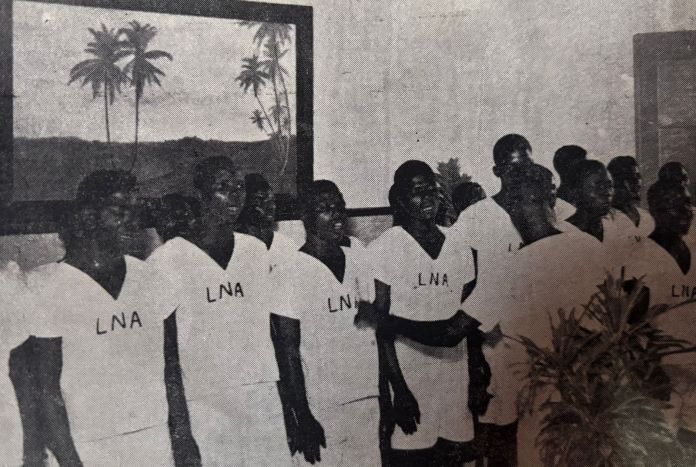Secretário-Geral das Nações Unidas: “Os impérios coloniais distorceram a imagem de África”

Luanda, 25 de Novembro de 2025 – O Secretário-Geral das Nações Unidas, Eng.º António Guterres, considerou segunda-feira em Luanda que a colectânea angolana «Os Bantu na visão de Mafrano», antropologia cultural, ajuda a repor a dignidade dos povos subjugados pelos impérios coloniais, no continente africano.
António Guterres proferiu tal declaração durante um breve encontro realizado no Hotel Epic Sana, na capital angolana, durante o qual a família do autor já falecido, Maurício Francisco Caetano, “Mafrano”, lhe ofereceu os três volumes daquela obra póstuma, muito apreciada pelo mais alto dignatário das Nações Unidas. Entre os presentes destacou-se o coordenador em exercício do sistema das Nações Unidas em Angola, Diego Zorrilla Orsat, membros da comitiva de António Guterres e três familiares do autor.



«Os impérios coloniais distorceram a imagem de África e esta obra vem repor a dignidade destes povos», disse taxativamente o Secretário-Geral das Nações Unidas que se deslocou a Luanda de 23 a 25 de Novembro como convidado da sétima Cimeira União Africana – União Europeia, com a presença de um total de 76 Chefes de Estado e de Governo europeus e africanos.
Para a família do autor, esta colectânea sobre a antropologia cultural e a civilização Bantu terá certamente maior valia internacional se estiver também disponível em francês e inglês. «A obra enuncia um conjunto de princípios assentes na solidariedade humana que podem contribuir para a solução de conflitos e permitir um maior conhecimento e aproximação entre vários povos do mundo», disse José Caetano, filho do autor.
«Os Bantu na visão de Mafrano – Quase Memórias», antropologia cultural angolana, é uma obra em três volumes, 39 capítulos e 800 páginas que começou a ser esboçada em 2011, para ser concluída em Agosto de 2025. A colectânea teve como fonte um legado de estudos e textos dispersos em vários jornais e revistas, com ênfase para os jornais «O Apostolado», «Angola Norte», «O Angolense», a Revista Angola da Liga Nacional Africana, assim como um «Boletim» do Ministério das Finanças publicado já depois da independência de Angola.
O seu autor, o escritor e etnólogo angolano Maurício Francisco Caetano, “Mafrano”, observou os hábitos e costumes autóctones em localidades em que trabalhou desde os anos 40’s até à data da sua morte, em 1982, como Cabinda, Uíge, Malanje, Cuanza-Norte, Dembos e Luanda.
O primeiro volume foi apresentado em Abril e Maio de 2022, no Lubango, Huíla, e em Luanda, e prefaciado por Dom Zacarias Kamwenho, arcebispo emérito do Lubango, prémio Sakharov 2001, que considerou o autor como «o antropólogo maior de Angola».
O segundo volume da colectânea, foi apresentado em Luanda por Dom José Manuel Imbamba, Presidente da Conferência Episcopal de Luanda (CEAST), em Julho de 2023, em Luanda. Em Novembro de 2024 a obra foi distinguida pelo Ministério da Cultura de Angola com o Prémio Nacional de Cultura e Artes na modalidade de investigação em Ciências Humanas e Sociais.
Finalmente, o terceiro e último volume foi apresentado em Luanda, a 12 de Agosto de 2025, na Escola Nacional da Administração e Políticas Públicas (ENAPP), por Dom Filomeno Vieira Dias, Arcebispo de Luanda.
Maurício Caetano, foi director nacional do Ministério das Finanças, e membro fundador da União dos Escritores Angolanos (UEA). Destacou-se igualmente como professor em vários estabelecimentos de ensino.
Na infância, então menino órfão, Maurício Caetano teve como tutor um sacerdote santomense, o cónego José Pereira da Costa Frotta (1879-1954), que o recolheu na Escola da Missão Católica do Dondo, sua terra natal, e o levou posteriormente para o Seminário do Sagrado Coração de Jesus de Luanda, onde cursou Filosofia e Teologia.
Até esta data, a sua colectânea foi apresentada em Moçambique, Cabo-Verde, São Tomé e Príncipe, Portugal, Alemanha, Reino Unido e por vídeo conferência no Brasil.

“Jornal de Angola” de 27 de Novembro de 2025




















































